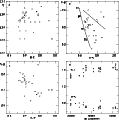Catalogues of emission-line stars which were compiled decades ago
(e.g., MWC, Merrill & Burwell 1933; AS, Merrill & Burwell
1950; LS, Stock et al. 1960)
contain a large number of unstudied objects. For most of these objects,
we only know that they display the H![]() line in emission. The attention
of researchers is usually attracted to these objects only when new
information becomes available, such as photometric variability, or the
detection of excess radiation in some spectral region.
This is the case for the two stars in the present paper.
line in emission. The attention
of researchers is usually attracted to these objects only when new
information becomes available, such as photometric variability, or the
detection of excess radiation in some spectral region.
This is the case for the two stars in the present paper.
All early-type emission-line stars are surrounded by a significant amount of circumstellar gas (for instance, due to a stellar wind or accretion) and, as a consequence, display IR excesses due to free-free and free-bound radiation. Some are also surrounded by dusty envelopes, which can be either remnants of the protostellar collapse at the pre-main-sequence stage of evolution or can be formed in the outer parts of the wind for more evolved stars. If dust is present in the circumstellar environment, the IR excesses are more prominent, especially in the mid- and far-IR region, and in some cases may have been detected by the IRAS satellite. To identify such objects, cross-identification of the sources from the catalogue of galactic early-type emission-line stars by Wackerling (1970) with those of the IRAS Point Source Catalogue (PSC) was carried out by Dong & Hu (1991).
 |
Figure 1: Brightness and colour variations of AS 78. a) Colour-magnitude diagram; b) and c) colour-colour diagrams; d) temporal variations of B-V (filled circles) and V-I (open circles). Different symbols in panels a), b), and c) represent data obtained in different years: 1993 (open circles), 1994 (filled circles), 1995 (open traingles), 1996 (filled triangles), 1998/9 (pluses). The solid line in panel b) shows intrinsic colour-indices of B-type dwarfs from Strajzhys (1977) shifted along the interstellar reddening vector EU-B/EB-V = 0.84 (dashed line) at EB-V = 0.85 |
These authors selected only objects with a very strong IR excess,
![]() 8 mag, and found 187 such objects. Only about
30% of this sample consists of objects with a known nature: Herbig Ae/Be
stars, LBVs, Wolf-Rayet stars, symbiotic and VV Cep binary systems, and
H II regions. Most of the other objects have not been investigated yet.
Studying the spatial distribution of these objects, Dong & Hu found them to
belong to the extreme Population I and concluded that they provided a
rather complete sample for further study of the evolution of pre- and
post-main-sequence stars of intermediate and high masses with these
properties. The selection criterion used was rather crude, but it enabled
the authors
to find objects in which the circumstellar processes are highly active.
Thus, new information about the poorly-studied objects from this list is
important for our understanding of the evolution of stars and their envelopes.
8 mag, and found 187 such objects. Only about
30% of this sample consists of objects with a known nature: Herbig Ae/Be
stars, LBVs, Wolf-Rayet stars, symbiotic and VV Cep binary systems, and
H II regions. Most of the other objects have not been investigated yet.
Studying the spatial distribution of these objects, Dong & Hu found them to
belong to the extreme Population I and concluded that they provided a
rather complete sample for further study of the evolution of pre- and
post-main-sequence stars of intermediate and high masses with these
properties. The selection criterion used was rather crude, but it enabled
the authors
to find objects in which the circumstellar processes are highly active.
Thus, new information about the poorly-studied objects from this list is
important for our understanding of the evolution of stars and their envelopes.
In 1993 we began a study of a subsample of Dong & Hu's list which
contains most of their northern objects (north of
![]() declination).
These objects may display similar properties while having quite different
natures and evolutionary states. Because of that, we have been grouping
them on the basis of either similar observational characteristics or closeness
in their physical parameters. Our first results were briefly presented at the
Workshop on B[e] stars (Kuratov et al. 1998; Sheikina & Miroshnichenko
1998).
declination).
These objects may display similar properties while having quite different
natures and evolutionary states. Because of that, we have been grouping
them on the basis of either similar observational characteristics or closeness
in their physical parameters. Our first results were briefly presented at the
Workshop on B[e] stars (Kuratov et al. 1998; Sheikina & Miroshnichenko
1998).
In the course of this study we obtained photometric and spectroscopic observations of two poorly-studied objects, AS 78 and MWC 657. Analysis showed that their properties are similar to those of B[e] stars with hot circumstellar dust (Miroshnichenko et al. 1999). Our previous study of MWC 657 (Miroshnichenko et al. 1997) was limited to only photometric data and resulted in rough estimates of the star's fundamental parameters. Here we present the results of our spectroscopic and photometric analyses for both objects, including estimates of the main characteristics of the stars and their surrounding circumstellar matter. The observations are described in Sect. 2, results and discussion in Sect. 3, and our conclusions are given in Sect. 5.
Copyright The European Southern Observatory (ESO)